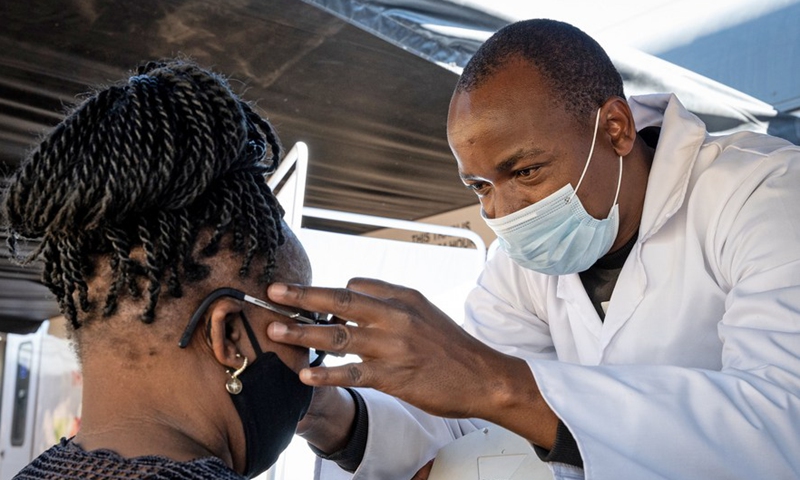One child or youth under 20 infected with HIV every 100 seconds: UNICEF
Source: Xinhua Published: 2020/11/26 13:58:21
Approximately once every minute and 40 seconds, a child or young person under the age of 20 was infected with HIV last year, the UN Children's Fund (UNICEF) said on Wednesday.

Prevention efforts and treatment for children remain some of the lowest amongst key affected populations, and in 2019, a little less than half of children worldwide did not have access to life-saving treatment, UNICEF said in a new report.
Nearly 320,000 children and adolescents were newly infected with HIV and 110,000 children died of AIDS last year.
"Children are still getting infected at alarming rates, and they are still dying from AIDS. This was even before COVID-19 interrupted vital HIV treatment and prevention services putting countless more lives at risk," said UNICEF Executive Director Henrietta Fore.
According to UNICEF, the COVID-19 pandemic has worsened inequalities in access to life-saving HIV services for children, adolescents and pregnant mothers everywhere, and there are serious concerns that one-third of high HIV burden countries could face coronavirus-related disruptions.
"Even as the world struggles in the midst of an ongoing global pandemic, hundreds of thousands of children continue to suffer the ravages of the HIV epidemic," said Fore.
Data from the Joint UN Programme on HIV/AIDS (UNAIDS), cited in the report, showed the impact of control measures, supply chain disruptions, lack of personal protective equipment, and the redeployment of healthcare workers on HIV services.
Pediatric HIV treatment and viral load testing in children in some countries fell by 50 to 70 percent, and new treatment initiation by 25 to 50 percent in April and May, coinciding with partial and full lockdowns to control the novel coronavirus.
Health facility deliveries and maternal treatment were also reported to have reduced by 20 to 60 percent, maternal HIV testing and antiretroviral therapy (ART) initiation by 25 to 50 percent, and infant testing services by approximately 10 percent.
Though the easing of control measures and the strategic targeting of children and pregnant mothers have successfully led to a rebound of services in recent months, challenges remain, and the world is still far from achieving the global 2020 pediatric HIV targets, said UNICEF.
Despite some progress in the decades-long fight against HIV and AIDS, deep regional disparities persist among all populations, especially for children.
While the Middle East and North Africa region recorded 81 percent pediatric ART coverage, only 46 percent and 32 percent were covered in Latin America and the Caribbean, West and Central Africa, respectively.
The South Asia region recorded 76 percent coverage, Eastern and Southern Africa 58 percent, and East Asia and the Pacific 50 percent.

A doctor performs an eye test with a patient on the Phelophepa Health train in Springs, Johannesburg, South Africa, Sept. 10, 2020. The train is made up of 5 clinics and was initially used during the HIV/AIDS pandemic. Now it renders COVID-19 testing as well as normal services. (Xinhua/Yeshiel)
Prevention efforts and treatment for children remain some of the lowest amongst key affected populations, and in 2019, a little less than half of children worldwide did not have access to life-saving treatment, UNICEF said in a new report.
Nearly 320,000 children and adolescents were newly infected with HIV and 110,000 children died of AIDS last year.
"Children are still getting infected at alarming rates, and they are still dying from AIDS. This was even before COVID-19 interrupted vital HIV treatment and prevention services putting countless more lives at risk," said UNICEF Executive Director Henrietta Fore.
According to UNICEF, the COVID-19 pandemic has worsened inequalities in access to life-saving HIV services for children, adolescents and pregnant mothers everywhere, and there are serious concerns that one-third of high HIV burden countries could face coronavirus-related disruptions.
"Even as the world struggles in the midst of an ongoing global pandemic, hundreds of thousands of children continue to suffer the ravages of the HIV epidemic," said Fore.
Data from the Joint UN Programme on HIV/AIDS (UNAIDS), cited in the report, showed the impact of control measures, supply chain disruptions, lack of personal protective equipment, and the redeployment of healthcare workers on HIV services.
Pediatric HIV treatment and viral load testing in children in some countries fell by 50 to 70 percent, and new treatment initiation by 25 to 50 percent in April and May, coinciding with partial and full lockdowns to control the novel coronavirus.
Health facility deliveries and maternal treatment were also reported to have reduced by 20 to 60 percent, maternal HIV testing and antiretroviral therapy (ART) initiation by 25 to 50 percent, and infant testing services by approximately 10 percent.
Though the easing of control measures and the strategic targeting of children and pregnant mothers have successfully led to a rebound of services in recent months, challenges remain, and the world is still far from achieving the global 2020 pediatric HIV targets, said UNICEF.
Despite some progress in the decades-long fight against HIV and AIDS, deep regional disparities persist among all populations, especially for children.
While the Middle East and North Africa region recorded 81 percent pediatric ART coverage, only 46 percent and 32 percent were covered in Latin America and the Caribbean, West and Central Africa, respectively.
The South Asia region recorded 76 percent coverage, Eastern and Southern Africa 58 percent, and East Asia and the Pacific 50 percent.
Posted in: CROSS-BORDERS,WORLD FOCUS